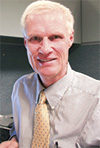As I enter my second year here in Washington, D.C., the topic of training arrived in my inbox. As Department of State Civilian Response Corps active members, we are required to complete eight weeks of training each year, so I glance at the schedule and list of courses.
Nothing on this list interests me. In this column, let me explain why.
I often claim that in the work of development, especially overseas, the environment consists of two different components. One, the physical landscape, is comprised of the empirical attributes that can be measured, seen, touched and generally understood. On a farm, for instance, these include the land, fields, soils, crops, buildings, cows, barns and so on.
The landowner knows these very well and, most importantly, knows the changes over time. The increases in soil fertility, the depreciation of a barn and the health of the cow herd are examples of changes per unit of time.
Scientists understand that we must inventory and evaluate these physical attributes, and we call this cognitive knowledge. We have the tools, the instruments and the methodologies to describe both the fixed point in time and the changes as flux over a time frame.
Believe me, these are straightforward skills and even the interpretation of trends is reasonably well understood. Every landowner evaluates performance of crop growth, milk production or herd size using cognitive skills (e.g., records and inventory accounting followed by evaluation and interpretation).
The inventory and evaluation processes are largely mechanistic; thus, we all have a reasonably straightforward operating procedure for obtaining cognitive knowledge.
At our universities, entire programs are grounded in increasing cognitive knowledge so we may, throughout our lives, survey and evaluate the physical landscape. Our goal is making beneficial decisions that bring added value to the physical landscape.
In fact, trend analysis is cognitively learning in what direction a variable is moving. Is milk production increasing? Is herd health improving? Is my return on investment greater?
Yet there is a second component of interest: the human landscape. It is no accident that one of the first steps in our NRCS conservation planner’s handbook is learning all we can about the landowner’s goals and considerations (the human landscape).
In fact, if we miss this step, we overbuild, spend too much money and may encumber the landowner with a series of conservation practices that cannot be supported or sustained.
We can make a short leap to international development as well. My premise is the cognitive exercise of inventory collection, and then the evaluation and assessment component is relatively straightforward. We have many engineers, scientists and practitioners already in the field doing this work.
In fact, our own agency, NRCS, sends teams of people overseas to help the host country improve one or more variables in the physical landscape.
But we have largely forgotten the human landscape. Many reports now coming out of our many years of developmental work in Afghanistan and Iraq clearly make the case for programs/projects based almost entirely on improving the physical landscape; a structure was built, a training course was delivered, and governance model was installed.
Yet sadly, we come back a few months later and the output of these programs are no longer functioning or even there. The long-term sustainability is mostly absent, and this sad story results in the squandering of our huge investment of dollars and human effort.
My claim to this discussion is clear: We have not surveyed the human landscape. We have not evaluated the social and cultural domain by asking the right questions to those on the ground expecting to operate, manage and maintain this output.
We built a structure without sufficient consideration given to its sustainability. We have delivered training without asking what will happen when the educated man or woman returns home with no changes in the work environment.
Let me introduce the term intuition. The term denotes a level of knowledge already gained from years of service and many life experiences.
We cannot deliver intuition in the classroom or the laboratory. We do this in the field, over and over, gaining the collective data of inventory and evaluation so that instead of using strictly cognitive skills, we intuitively know the answers to simple and often complex problems.
Further, such intuition may be cognitive knowledge in very fast motion. For example, within minutes of surveying a farm, we already know the constraints that limit or hold back the trend of some variable towards something beneficial.
Intuition can apply to the human landscape as well. The wisdom obtained from years in the field, certainly including years and decades of talking to people. We size them up readily, but only if we have the years already spent.
The combination of cognitive knowledge coupled with intuition results in a better understanding of both the physical landscape and the human landscape. Scientists can work in complex environments when they have some understanding of the humanities.
Sociologists provide greater value when they have some understanding of the cognitive skills necessary to understand the mechanics of both deterministic and stochastic outcomes.
Another way to write this might be: The physical landscape is largely deterministic and mechanistic, although complexity may result in a wide range of variables that we call stochastic outcomes.
But when we also include the human landscape, the variables of human society and culture at the larger level and the emotions and feeling at the individual level, then we have a broader understanding of what, when, where and to what extent our efforts should be spent.
Of all the frustrations we may have working in the overseas developmental realm, one of the biggest is that we lack sufficient understanding of the human landscape. Whatever we may identify as a problem, we look too much at just the physical landscape for the root cause, and very little effort is spent at evaluating the human landscape.
Which brings me back to training. The list includes the usual cognitively based training in the physical landscape. I see very little in the human landscape … and I wrote already that this is a skill we cannot learn in the classroom. We must have field experience and years, or decades, of service.
My suggestion to the planner’s shop is to bring some wise field people into the classroom and let them talk about how they evaluate the human landscape. The U.S. military has just such a group of professionals that make up the Human Terrain System. I worked with them in Iraq and spent many a long night at a DFAC (dining facility) learning from them.
Their job was clear: Provide the brigade commander with the societal and cultural insight gained from their work in the field.
Some scoffed at their work. I did not. They were trained in the humanities and then in the field, using skills to understand the human landscape. This insight into the workings of the host people was largely intuitively based; we do not have a mind/brain meter we can hook up and measure what is there emotionally or what level of interest and feelings exists.
Not everyone agrees with these ideas. The listing of training courses bears this out. Nevertheless, I am convinced that a combination of cognitive skills with intuition and years of insight are hugely valuable not only overseas, but right here at home.
Or as I make the case for my next long-term deployment, I would like to have a rural sociologist with me. As an equal, not subservient. Maybe I will get my wish someday … PD

-
Mike Gangwer
- Agricultural Scientist
- USDA-NRCS
- Email Mike Gangwer





